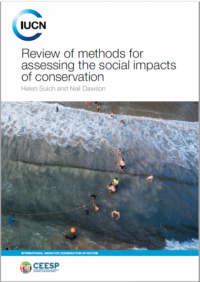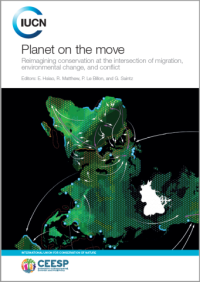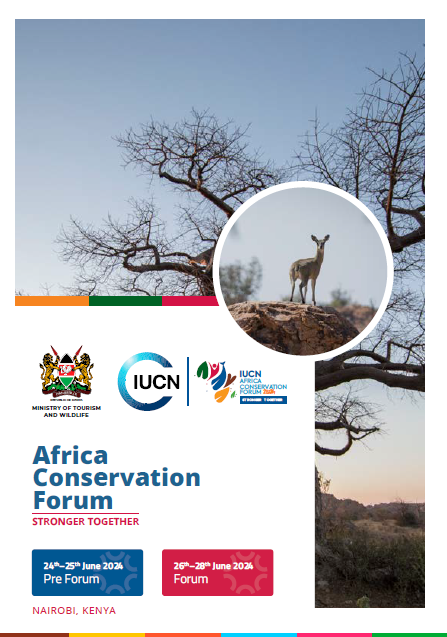Assessing the social impacts of conservation: A review of methods
Helen Suich (independent resercher) and Neil Dawson (IUCN CEESP Chair of Human Wellbeing and Sustainable Livelihoods), report authors
This report examines methods and tools for evaluating the social impacts of conservation interventions and provides guidance for practitioners on best practices. Social impacts encompass various dimensions, including economic, social, cultural, political, environmental, and psychological aspects, affecting all individuals connected to the ecosystem, biodiversity, or location in question, not limited to Indigenous Peoples and local communities. It focuses on tools for assessing impacts after interventions have begun while acknowledging the importance of incorporating social impact assessments from the project's inception.
There are a variety of methods, approaches and tools that can be used to investigate different impacts on people arising from conservation activities, regardless of whether they are implemented in protected areas, community conservation areas or via other conservation interventions. However, it can be difficult for practitioners to select and design the most appropriate approach to suit their needs and to contribute to existing governance arrangements.
This report first reviews the available methods, tools and approaches that have been designed to assess and document the social impacts of conservation interventions, and second, offers guidance for practitioners on good practice for designing studies and facilitating processes for such assessments. The focus of this report is on tools that can be used for assessing ex post impacts – i.e. after commencement of intervention – whilst recognising that good project design incorporates social impact assessment activities from the outset.
In order to find the widest range of material possible to review, the literature search included four steps: (i) a search of the scholarly literature; (ii) a search of the grey literature; (iii) a snowball sample; and (iv) a request for information from the CEESP membership via the listserv. The reviewed papers were assessed across a number of categories including, but not limited to, the impact domains covered, whether assessed impacts were positive and/or negative, whether intended and/or unintended consequences were assessed, the distribution of impacts, whether the approach enabled disaggregated data analysis and the required resourcing.
A review of empirical papers assessing the social impacts of conservation initiatives was also conducted, and highlights the very partial nature of a majority of published social impact assessments.
This report also reviews seven approaches to social impact assessment, and summarises and links to papers and reports that review other appropriate approaches.
Based on the findings, guidance is provided on key issues that are critical to the design of good practice social impact assessments. The aspects emphasized were selected because of their significant impact on the quality and content of an assessment, and because they are often afforded insufficient attention in methods documentation, and are poorly integrated (or not integrated at all) in empirical studies.
Three good practices are emphasised, because while papers describing assessment methods note their importance in enabling an informative, inclusive and accountable social impact assessment, they appear to be infrequently implemented in published assessments. These are the practices of ensuring meaningful community participation and ethical conduct, ensuring an appropriate and informed design, and giving attention to the three aspects of equity: recognition, procedure and distribution.
This report also provides guidance on designing a social impact assessment, selecting appropriate methods and good practice principles to be followed throughout the assessment process. Good design requires ample consideration be given to specifying the questions that are to be answered by the assessment, to identifying an appropriate assessment framework and approach to explore those questions, and instigating effective assessment procedures and interactions, including integrating with site-level governance and involving stakeholders. The empirical review suggests these design questions have often been treated superficially, and often implicitly, in assessments to date. Rather than relying on standardised toolkits to prescribe the scope and methods for any conservation social impact assessment, the framework, the domains to be assessed and appropriate data collection tools should be determined through deliberative discussions. Notably, empirical studies and assessment reports seldom provide adequate justification for the choices made, including why certain issues and potential impacts have been excluded (for example, cultural practices, customary governance systems and rights are often overlooked), and why those selected were prioritised.
Adherence to good practices and mainstreaming of robust and informative social impact assessments within conservation decision making are important to support progress towards better and more equitable governance. High quality, integrated social impact assessments are also a potentially crucial pathway to enhance accountability for social standards in conservation, particularly in the context of the rapid expansion of conservation initiatives that has been enshrined in the Global Biodiversity Framework targets for 2030.




